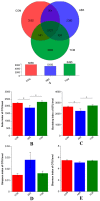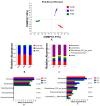Effects of Traditional Chinese Herbal Feed Additive on Production Performance, Egg Quality, Antioxidant Capacity, Immunity and Intestinal Health of Laying Hens
- PMID: 37570319
- PMCID: PMC10417022
- DOI: 10.3390/ani13152510
Effects of Traditional Chinese Herbal Feed Additive on Production Performance, Egg Quality, Antioxidant Capacity, Immunity and Intestinal Health of Laying Hens
Abstract
Chinese herbs have been used as feed additives in animal production. This study investigated the effects of a Chinese herbal feed-additive (TCM, which contained Elsholtzia ciliate, Atractylodes macrocephala, Punica granatum pericarpium, and Cyperus rotundus) on the production performance, egg quality, antioxidant capacity, immunity, and intestinal health of Roman laying hens. A total of 720 28-week-old hens were randomly allotted to three groups with six replicates of forty hens each. The groups were fed a basal diet (CON group), a basal diet with 50 mg/kg zinc bacitracin (ABX group), or a basal diet with 400 mg/kg TCM (TCM group) for 56 days. The results showed that the TCM group increased egg production, egg mass, albumen height, and Haugh unit compared with the CON group (p < 0.05). There were no significant differences in egg weight, feed intake, feed conversion rate, and eggshell strength among all three groups (p > 0.05). Compared with the CON group, the TCM group enhanced the activities of glutathione peroxidase, total antioxidant capacity, and superoxide dismutase in serum and liver, and reduced malondialdehyde content (p < 0.05). The TCM also increased the levels of interleukin-2, interferon-γ, immunoglobulin A, immunoglobulin M, and immunoglobulin G, and decreased the levels of interleukin-6 and interleukin-8 compared with the CON group (p < 0.05). Furthermore, the TCM group increased jejunal goblet cell density and decreased ileal crypt depth and lymphocyte density compared with the CON group (p < 0.05). The results of 16S rRNA demonstrated that the TCM can change the diversity and composition of intestinal microbiota. At the phylum level, the abundance of Bacteroides increased while that of Firmicutes decreased in the TCM group (p > 0.05). At the genus level, the abundance of Lactobacillus, Rikenellaceae_RC9_gut_group, and Phascolarctobacterium increased while that of Bacteroides and unclassified_o__Bacteroidales decreased in the TCM group (p > 0.05). The effects of ABX were weaker than those of the TCM. In conclusion, the TCM has positive effects on production performance and the intestinal health of hens.
Keywords: antioxidant capacity; egg quality; immunity; intestinal health; laying hens; production performance; traditional Chinese herbal feed additive.
Conflict of interest statement
The authors declare no conflict of interest.
Figures



Similar articles
-
Alpiniae oxyphyllae fructus improves production performance and egg quality of laying breeder hens by regulating reproductive hormones, antioxidant function, immunity and intestinal health.Poult Sci. 2024 Jun;103(6):103770. doi: 10.1016/j.psj.2024.103770. Epub 2024 Apr 15. Poult Sci. 2024. PMID: 38652955 Free PMC article.
-
The impacts of fermented feed on laying performance, egg quality, immune function, intestinal morphology and microbiota of laying hens in the late laying cycle.Animal. 2022 Dec;16(12):100676. doi: 10.1016/j.animal.2022.100676. Epub 2022 Nov 9. Animal. 2022. PMID: 36442324
-
Dietary Chinese herbal mixture supplementation improves production performance by regulating reproductive hormones, antioxidant capacity, immunity, and intestinal health of broiler breeders.Poult Sci. 2024 Jan;103(1):103201. doi: 10.1016/j.psj.2023.103201. Epub 2023 Oct 21. Poult Sci. 2024. PMID: 37980727 Free PMC article.
-
Pine (Pinus massoniana Lamb.) Needle Extract Supplementation Improves Performance, Egg Quality, Serum Parameters, and the Gut Microbiome in Laying Hens.Front Nutr. 2022 Feb 10;9:810462. doi: 10.3389/fnut.2022.810462. eCollection 2022. Front Nutr. 2022. PMID: 35223952 Free PMC article.
-
Physicochemical properties, mechanism of action of lycopene and its application in poultry and ruminant production.Front Vet Sci. 2024 Mar 18;11:1364589. doi: 10.3389/fvets.2024.1364589. eCollection 2024. Front Vet Sci. 2024. PMID: 38562916 Free PMC article. Review.
Cited by
-
Effects of adding a kind of compound bio-enzyme to the diet on the production performance, serum immunity, and intestinal health of Pekin ducks.Poult Sci. 2025 Jan;104(1):104506. doi: 10.1016/j.psj.2024.104506. Epub 2024 Nov 10. Poult Sci. 2025. PMID: 39700598 Free PMC article.
-
Modulatory effects of polyherbal mixture on the immuno-antioxidant capacity and intestinal health of chicks infected with Escherichia coli O78.Poult Sci. 2025 Jun;104(6):105156. doi: 10.1016/j.psj.2025.105156. Epub 2025 Apr 12. Poult Sci. 2025. PMID: 40239311 Free PMC article.
-
Molecular Mechanisms and Regulatory Factors Governing Feed Utilization Efficiency in Laying Hens: Insights for Sustainable Poultry Production and Breeding Optimization.Int J Mol Sci. 2025 Jul 2;26(13):6389. doi: 10.3390/ijms26136389. Int J Mol Sci. 2025. PMID: 40650167 Free PMC article. Review.
-
Dietary compounded traditional Chinese medicine residue meal improves laying performance, egg quality, and gut barrier integrity in late-phase laying hens.Poult Sci. 2025 Sep;104(9):105425. doi: 10.1016/j.psj.2025.105425. Epub 2025 Jun 11. Poult Sci. 2025. PMID: 40570464 Free PMC article.
-
Effects of Fagopyrum dibotrys rhizoma meal supplementation on productive performance, egg quality, egg nutritional value, and serum biochemical parameters of Shanma laying ducks.Front Vet Sci. 2025 Aug 6;12:1654416. doi: 10.3389/fvets.2025.1654416. eCollection 2025. Front Vet Sci. 2025. PMID: 40843253 Free PMC article.
References
-
- Chen J., Kang B., Yao K., Fu C., Zhao Y. Effects of dietary Macleaya cordata extract on growth performance, immune responses, antioxidant capacity, and intestinal development in weaned piglets. J. Appl. Anim. Res. 2019;47:349–356. doi: 10.1080/09712119.2019.1636800. - DOI
LinkOut - more resources
Full Text Sources

